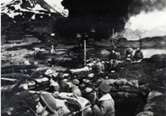-
Government
City Services-
DepartmentsCity Manager Administration City Clerk Finance Fire Department Human Resources Library Parks Culture and Recreation Planning Police Department Ports and Harbors Public Utilities Public Works
-
Mayor & City CouncilMayor & Council Agendas and Minutes Meeting Schedule Public Comment at Meetings Ordinances Resolutions Trip Reports City Code Annual Budget Lobbyist Reports Staff Directory
-
Committees & CommissionsHistoric Preservation Commission Library Advisory Committee Parks, Culture & Recreation Committee Planning Commission Apply to ServeElection InformationRegistering to Vote Polling Location Absentee Voting FAQ

Did You Know?
Did you know that the waters around Unalaska Island are one of the few places in the world to find the rare Whiskered Auklet?
-
-
Commerce
Port/Business-
PortPort Department Dock Facilities and Services AirportFisheriesCommercial Fishing Seasons Sport Fishing Seasons Fisheries Links Fisheries Reports Fish Species common in Alaska
-
BusinessBids and RFPs Business Directory Business Licensing Community Profile Economy Forms and Permits Shipping & Cargo Taxes Unalaska Visitors Bureau
-
TaxesPersonal Property Taxes Real Property Taxes Sales Taxes

Did You Know?
Did you know that Unalaska/Dutch Harbor was bombed by the Japanese during WWII?
-
-
Community
Residents/Visitors-
About UnalaskaCommunity Profile Economy Frequently Asked Questions History Is it Unalaska or Dutch Harbor? Passenger Transportation Photo Galleries Plants Population Shipping and Cargo Weather Wildlife WWII in the Aleutians
-
VisitorsVisitor Bureau Library Museum of the Aleutians Parks & Trails Passenger Transportation Sport Fishing Seasons Things To See & Do Tour Operators WWII National Historic Area and Visitor Center
-
ResidentsAnnual Festivals and Events Community Calendar Emergency Preparedness Health Care Library Non Profits & Community Services Parks & Trails Recreation Schools Sport Fishing Seasons

Did You Know?
Did you know that Unalaska is 800 miles from Anchorage and farther West than Hawaii?
-
-
I want to...
Help Center-
ApplyJob Board/Commission Building Permit Burn Permit Business License Fireworks Permit Pet LicenseContactStaff DirectoryRequestPublic Records Public Safety Records Utility Service
-
PaymentsUtilities TaxesRegisterVoter Registration Vehicle RegistrationReportBuilding Code Violation Road Maintenance Issue Street Light Outage Animal Control Issues
-
ViewAgendas and Minutes Annual Budget Bids & RFPs Code of Ordinances Calendar of Meetings Community Events Documents, Reports, & Presentations Forms, Permits & Applications Property Parcel Info Schedule of Fees & Charges Mapping & GIS

Did You Know?
That Unalaska’s Port of Dutch Harbor is the #1 Commercial Fishing Port in the United States, based on quantity of the catch and has been for more than 25 years?
Find Out More-
History
The native Unangan people have inhabited the island of Unalaska for thousands of years. The Unangan developed an intricate and complex society, and a maritime culture superbly adapted to sea mammal hunting and fishing in some of the world’s richest waters. Artifacts at the Museum of the Aleutians illustrate that the Unangan were a very skilled people, possessing excellent workmanship. The Unangan are widely known in particular for ultra-fine grass basketry, sleek and efficient wood-frame kayak or “iqyan”, a skin boat, and mastery in handling the iqyan at sea, excellence as marine mammal hunters, superior skin sewing and embroidery techniques, and beautiful, streamlined bentwood hats and visors. Artifacts, stories, and recreations of the rich Unangan culture can be viewed and studied at the Museum of the Aleutians, with many artifacts dating back roughly 9,000 years.
Commerce with Russian fur traders began in 1759 when Stepan Glotov and accompanying fur hunters spent two years on Unalaska and nearby Umnak Island. The name “Aleut” came from Russian explorers, and its meaning is obscure, so the present-day natives of Unalaska and most of the Aleutian Islands prefer the term Unangan.
Under Russian control, the Unangan were consolidated into fewer and fewer communities to expedite the efficiency in which the Russians could take advantage of their hunting skills. The decline of the Unangan population was rapid and occurred for varied reasons, from out-and-out genocide to contact diseases brought by the newcomers.
Russian Orthodox missionary Father Ioann Veniamenov arrived in Unalaska for pastoral appointment on July 24, 1824. He lived at Unalaska for ten years, during which time he rebuilt the Orthodox chapel, learned the native language, devised an “Aleut” alphabet, opened an elementary school, and translated the Russian Short Catechism and the Gospel of St. Matthew into the native language. Among other accomplishments, he also made pastoral visits to villages along the chain and in the Pribilof Islands by iqyan in fair weather and foul.
The Russian influence is best viewed by touring the Cathedral of the Holy Ascension, a Russian Orthodox Cathedral and one of the oldest cruciform-style Russian churches in the country. The cathedral is a National Historic Landmark and houses one of Alaska's largest and richest collections of Russian artifacts, religious icons and art pieces, some having been donated to the church directly from Catherine the Great.
Unalaska was occupied by U.S. armed forces during World War II. The build-up began in 1941 and the influx of construction crews and armed forces personnel forever changed the face of the village. On June 3 and 4, 1942, Unalaska was bombed by the Japanese. Shortly thereafter, all Native residents were forced to leave the island and were interned in camps in Southeast Alaska where overcrowding and unsanitary conditions were the norm, and many lives were lost. This was not a military evacuation particular to Unalaska Island; the entire native population of the Aleutian region was evacuated, as well as the Pribilof Islands to the north. When the people returned in 1945, they found that U.S. troops had ransacked and vandalized most of their homes. Four small villages were never repopulated (Attu, Makushin, Kashega and Biorka) and their returning inhabitants were absorbed into Unalaska’s native population.
Unalaska’s International Port of Dutch Harbor is now the #1 Fishing Port in the nation, a distinction held for more than twenty years. Unalaska is also the home of a protected deep water port that is ice free year round and hosts large marine cranes serving two major international shipping companies as a stopover port for domestic and international shipping.
